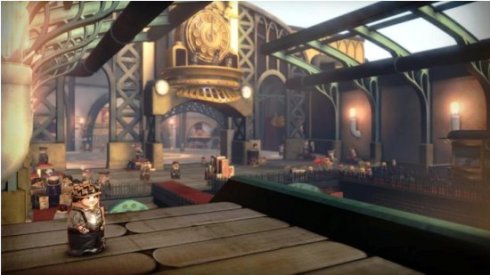Did I just ‘sip tea’ as an attack? I think I did. Wonderful, what next? Ah, obviously I’ll tell these people to get out of my way. Bulletstorm appears to be gaining acclaim for inventive gameplay, but it’s archaic when compared with Tim Schafer’s latest release, Stacking. After the excellent Psychonauts and the underrated Brutal Legend, Double Fine (Schafer’s development company) turned to download-only releases and it’s been a resounding success so far. As the mainstream stagnates and physical releases become ever more bland, Double Fine have carved out a niche for intelligent and unique titles. Costume Quest was the first and Stacking the glorious follow-up.
A combination of adventure and puzzle game, Stacking has a gameplay mechanic that other developers have failed utterly to implement. Remember the altogether disappointing ‘Messiah’ from 2000? You could be forgiven for being unable to, but if you do, you’ll remember it offered the ability to possess other characters and use their abilities. The problems this presented were that firstly, most human characters are essentially the same and second, it takes an imaginative mind to make this in any way useful in terms of gameplay. Schafer is one such creative mind and thankfully Stacking fails to suffer from use of something so complex. Rather, the game makes the whole concept seem remarkably simple, and therein lies the brilliance of Double Fine’s latest creation.
Using Russian Stacking Dolls as characters allows the player to inhabit the body of larger dolls and use their ability, so you can go from a small child to a tea-sipping lady, to an elderly gent struggling with his hearing. If that sounds utterly ridiculous, that’s because it is. Stacking is a game with its tongue firmly lodged in its cheek and each and every doll has a charm all its own. Gameplay is simple, with left stick moving, right stick controlling the camera and the four main buttons controlling entering and exiting dolls, talking and using a unique ability, each doll has one. These abilities are used to solve the puzzles presented, in a similar manner to the classic adventure games which made Schafer’s name. Each doll is akin to an item, some can open doors, others can distract guards and so on. It’s all extremely easy to play, though the puzzles are satisfyingly tough.
Each obstacle presented by the game can be overcome in several ways, using different dolls and their abilities, which avoids the major pitfall of the adventure game – a lack of creative freedom. Stacking asks players to be intelligent, rather than just lucky, and there are no absurd item combinations or illogical answers. Each problem has a common sense solution or two and gameplay is a simple matter of finding the right doll for the job, then having the imagination to use it. An early example is distracting a guard with a ‘sexy’ doll who can seduce him from his post. Later puzzles involve quite silly abilities and often elicit a laugh, such is their absurdity. Stacking amuses and delights in equal measure, and a large amount of effort has clearly gone into creating an experience that feels a world away from the average game.
Further setting Stacking apart is the setting. Opening with a silent movie style introduction, with a family of dolls gyrating, followed by cards showing what they have said. An evil Baron has kidnapped children, and the youngest child must rescue them. Nothing too complex, but the presentation is exquisite. Cut-scenes move between location theatre style, sets fall away and are replaced, rather than characters moving. The locales reflect the Russian doll styling and look like ‘The Last Express’ re-imagined by Pixar. This aesthetic style is a visual treat, with the dolls looking like painted wood, reflective and smooth, and backgrounds having a period style reminiscent of a drama set in 19th century Europe. Even the occasional tutorial is expertly presented, with a film-reel appearing on the edge of the screen as the game quickly introduces its controls and puzzles. The music also, is perfectly fitting, and creates an atmosphere of joviality without sacrificing the slow melancholic sound of the style it draws upon.
This sumptuous design is a rare treat in gaming. While many games have incredible graphics, few have this level of art design and ultimately that is far more impressive. Even the simplest of elements, the way the dolls move, is brilliantly realised. They all move by gently rocking from left to right, but some are more or less pronounced depending on personality. The aforementioned ‘sexy’ doll rocks the top part of her body as if rocking her hips, while other dolls move in a manner which reveals the smaller doll beneath. Attention to detail like this makes Stacking constantly interesting and appealing, as each new doll is more than just a new ability in a pretty shell, but a character all its own. You will likely spend a few moments just walking around looking at the dolls in each new location, wondering which to control first.
Stacking is a genuinely new experience, feeling like little else, and looking more like a CGI cartoon than a game. It’s full of the kind of humour and personality Schafer’s games have become known for while addressing the problems adventure games often fall victim to. This is the evolution of the point and click into something far more intuitive. It’s clever in so many little ways that it shames the average mainstream release. In times past this would have been one of the biggest releases of the year, rather than an afterthought to the likes of ‘Worst Game Title Ever Award Winner’ Killzone 3 or Bulletstorm. It’s a pity many will miss out on this due to its non-physical release and the relative obscurity that brings, as not only is it the best game of the year so far, but will be a definite contender for game of the year when December comes. On the other hand, sometimes finding and appreciating a game like Stacking makes it that much more special.






My husband is a big video game player, and I am a very reluctant player, usually losing interest after a few minutes, or not having the skills needed to succeed in the game. But after reading about Stacking, I asked my husband to download it and I loved it! Played by myself and with him, working together to solve the puzzles. Hurray for games that are clever, thoughtful, fun, and easy to master. Thanks for the great review.
You’re very welcome! It really is a lot of fun, it’s a pity there’s so few games like it. The only ones I can think of that come close are the Professor Layton games for the DS, but Stacking is a lot more fun.